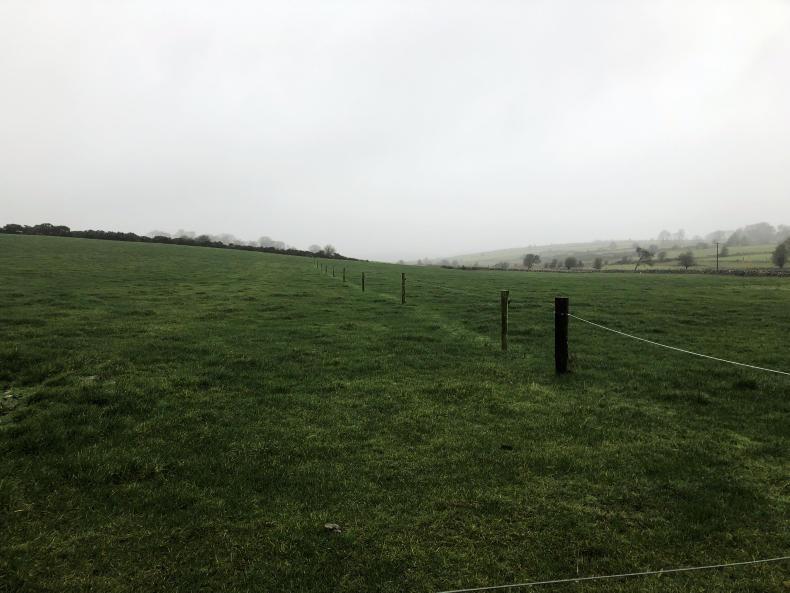Teagasc/Irish Farmers Journal BETTER Farm beef challenge participant Padraig O’Connor farms 52ha of high-quality, free-draining ground in Knockcroghery, in Co Roscommon. The land is divided into three blocks, both out-blocks are a very short distance away, and one even has a slatted shed situated on it.
On 52ha, Padraig is running just under 60 suckler cows. Upon the commencement of the programme in spring 2017, he had 52 cows to calve. This number has since risen to 58 animals for calving in spring 2019; comprised of 14 heifers and 44 cows. Historically, the cow type on the farm would have been primarily Angus cross and Limousin cross from the dairy herd, with a splash of continental running through. Over the past number of years, Padraig has developed a preference for Salers cross cows and is keen to breed more into the herd: “We had too much Angus and I felt they were always a little too small and too fat. The Salers are excellent cows to calve and they give me more peace of mind when using continental sires.”
A busy spring
With a young family at home and other family commitments to consider, Padraig says one of the most important management factors on the farm is efficiency, something he is working on with BETTER Farm adviser John Greaney and local B&T adviser James Kelly. Included in that is the necessity of having a very tight calving pattern: “I have always been very strict on keeping a tight calving pattern within the herd. It means I have a very busy few weeks but the work is more streamlined which I need.” He added: “To be honest, any calf born in April is too late anyway. He is always going to be playing catch-up.”
However, with these things considered, even a brief look at the herd’s fertility and calving performance shows that a strive for a tight calving pattern does not have to come at the detriment of breeding performance. This year, bulls went out on 24 April and were pulled away again at the end of July. Scanning showed 58 pregnant animals out of a possible 62, marking an impressive 94% conception rate in just nine weeks. He added: “if I have enough cows in-calf and one or two are going to be late they will be sold to avoid any calves being born in April.” As a result, 58 animals are due between 1 February and 25 March. Admittedly, a tight calving pattern puts pressure on both man and yard, particularly if weather turns for the worse like it did in the spring just passed. Saying that, Padraig has the sheds set-up to give himself the best possible chance in even the worst-case scenario. “I have plenty of creep areas for cows and calves after calving, which is important but after a week or 10 days I’d be getting them out to grass if at all possible,” he said. “Last year was the first time I’ve ever had to bring cows and calves back in, but even still, because I had a creep area backing onto a field, the door was left open and calves could walk out of the shed as they pleased.” Padraig couldn’t stress enough how well this worked and it is something he would certainly do again: “the cows and calves will bawl for an hour or two but they figure it out pretty quickly. They like to get outside into the fresh air and I’m certain it was the reason I avoided any health problems during the spring. I know not everyone has a shed with access direct to a field but it’s certainly an option for some lads.”
A prosperous spring
With such a good back-end to the year, many farmers have been commenting on how well the land is looking for the time of year. More often than not, land can look at its worst in December, after frantic attempts to maximise grazing in wet autumn conditions. Thankfully, this autumn has been quite the opposite and, in general, land is in good condition on many farms. As a bonus, good re-growths on ground closed early means there is strong grass covers in places signalling a good prospect for grazing next spring. This is exactly the case for Padraig too: “most of the land got slurry in the last week or two of October before the deadline and it got a great response. It’s a pity that deadline isn’t permanent because the extra two weeks made a huge difference I feel.” There are plenty of good covers on the farm, as can be seen from the grass wedge generated after a closing grass cover was taken last week (Figure 1). Average farm cover is 504kg DM/ha which is on the money for this time of year. Even land with lower covers have a good colour and are showing good prospects of growth for spring 2019. “It will all get half a bag of urea per acre at the beginning of February and hopefully it should kick-on from then,” Padraig concluded.






 This is a subscriber-only article
This is a subscriber-only article









SHARING OPTIONS: